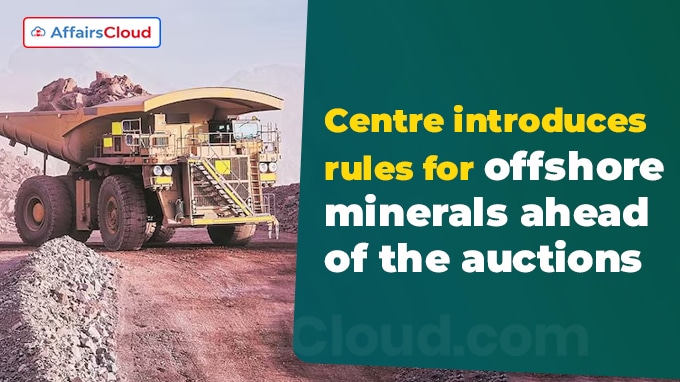 On 6th June 2024, Government of India(GoI) introduced “Offshore Areas (Existence of Mineral Resources) Rules, 2024”, a comprehensive regulatory framework which outlines exploration standards to ensure precise assessment and sustainable development of offshore mineral resources.
On 6th June 2024, Government of India(GoI) introduced “Offshore Areas (Existence of Mineral Resources) Rules, 2024”, a comprehensive regulatory framework which outlines exploration standards to ensure precise assessment and sustainable development of offshore mineral resources.
- The rules were issued by the GoI in exercise of the powers conferred by section 35 of the Offshore Areas Mineral (Development and Regulation) (OAMDR) Act, 2002 (17 of 2003).
Points to note:
i.The new regulations come ahead of the scheduled auction of 1st batch of offshore minerals blocks by the end of June-July, 2024.
ii.The Ministry of Mines has identified 10 offshore mineral blocks for inaugural round of offshore mineral auctions.
iii.The new rules define different stages of exploration, feasibility studies, economic viability assessments, and classification of mineral resources and reserves.
Key Features:
i.The new regulations lays down specific exploration rules for different types of deposits and minerals, including construction-grade silica sand, non-construction –grade calcareous sand, calcareous mud, phosphatic sediments, Rare Earth Element (REE) minerals, hydrothermal minerals and nodules, among others.
- This uniquely designed approach will ensure that each type of mineral deposit is thoroughly examined as per its unique characteristics and potential impact.
ii.The rules defines exploration for any mineral deposit in 4 stages: reconnaissance survey (G4), preliminary exploration (G3), general exploration (G2), and detailed exploration (G1).
- As per the new regulations, a minimum of G2 is mandatory to grant mining leases and G4 is required for obtaining composite licenses.
- These standards aim to provide a clear and structured approach to evaluate the presence and potential of mineral resources before extraction.
iii.The new rules categorizes Feasibility studies for offshore mineral resources into 3 stages:
- The geological study (F3) involves to document exploration activities and to assess mineral resources with a preliminary economic exploration.
- The pre-feasibility study (F2) assesses the potential techno-economic and social environment viability of the deposit, which further helps to identify preferred production and beneficial methods, and also includes a preliminary analysis.
- The feasibility study (F1) provides a comprehensive evaluation which confirms the technical, economic, and financial viability of mineral deposit.
iv.The new rules classified the economic viability of offshore mineral resources into 3 stages: intrinsically economic (E3), potentially economic (E2) and economic (E1). These 3 stages emphasis on technical and environmental assessments.
- For intrinsically economic (E3), resources are identified based on geological studies and show inherent economic interest. It is also required to assess their economic feasibility through pre-feasibility or feasibility studies.
- For potentially economic (E2), resources are identified through pre-feasibility or feasibility studies but, do not justify extraction.
- Econnomic resources covered under economic (E1), have been thoroughly examined through pre-feasibility or feasibility studies and assure profit under present conditions.
v.The new rules cover various minerals such as: silica sand, REEs, and hydrothermal minerals, with customized exploration approaches .
About Ministry of Mines:
Union Minister- G.Kishan Reddy (Constituency- Secunderabad, Telangana)
Minister of State (MoS) – Satish Chandra Dubey (Rajya Sabha- Bihar)




